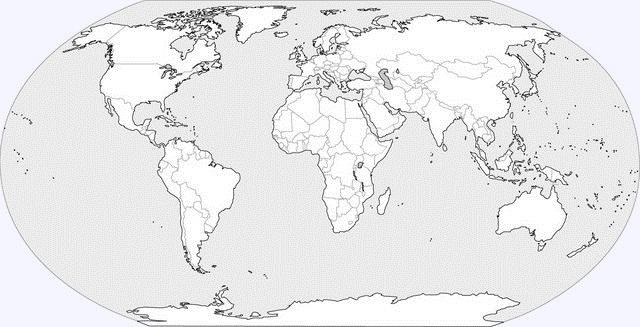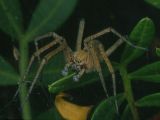|
Nombre común en ingles:
Spiny Leg Spiders
Nombre común en castellano:
Se desconoce
Familias similares:
Género tipo:
Zora Simon, 1878
Diagnosis:
Small to medium-sized araneomorph spiders; two tarsal
claws and claw tufts; ecribellate; entelegyne; eight eyes in three
rows; anterior legs with numerous ventral pairs of spines;
retrolateral tibial apophysis of male palp with basal process.
Caracteres descriptivos:
Caparazón:
oval, strongly narrowed in front with distinct cephalic area; fovea
well defined; sometimes with hair tufts near eyes. Sternunón:
shield-shaped or rounded without lateral extensions. Ojos:
eight; in two recurved rows or in three rows; then anterior lateral
eyes adjacent to posterior median eyes very much as in Ctenidae;
anterior lateral eyes the smallest; secondary eyes without tapetum
(Zora) or with canoe-shaped tapetum; clypeus fairly low. Quelíceros:
with small condyle; both margins with several teeth, most often
three on promargin, two on retromargin. Piezas bucales:
endites rectangular, parallel; serrula a single row of small teeth;
labium markedly shorter than endites, swollen in front, distally
straight. Patas: 4123; tarsi with two dentate claws, dense
claw tuft and scopula usually continued on distal part of metatarsi,
sometimes reaching their base; tarsi with double row of
trichobothria; four to eight pairs of ventral spines on tibiae and
one to three pairs on metatarsi; trochanters deeply notched; tarsal
organ capsulate. Palpo femenino:
with small claw, smooth (Zora) or dentate. Abdomen: oval,
longer than wide; with sparse cover of short recumbent hairs. Hileras:
six; with biarticulate anterior median and posterior lateral
spinnerets and uniarticulate posterior median ones; the former with
major ampullate gland spigot and few (Zora) or numerous piriforms;
cylindrical gland spigots on posterior median spinnerets in female
with tubular (Zora) or swollen base. Sistema respiratorio:
with a pair of booklung; tracheal spiracle just in front of
spinnerets, leading into unbranched tracheae; median tracheae
sometimes slightly branched (Argoctenus, Zora). Genitalia:
entelegyne; epigyne variable, usually with large lateral lobes
divided by central groove; male palpal tibia with retrolateral
apophysis provided with basal process (Zora); embolus usually short;
distinct hooked median apophysis and membranous conductor. Tamaño corporal:
3.5-19 mm. Color: yellowish with darker stripes; abdomen
yellow or greyish often with pattern of longitudinal stripes.
Estatus taxonómico:
The Zoridae have long been part of the Clubionidae. The composition
of the family is subject to debate, as it is apparently not
monophyletic (Silva, 2003), According to that study, Zora,
Argoctenus, Elassoctenus and Hestimodema form the Zoridae, sister to
the Miturgidae, whereas Odo and a few allies constitute the
sister-group of (Miturgidae Zoridae (Ctenidae)).
Distribución: Palearctic,
Australia, New Zeland, tropical America.

Estilo de vida: Zorids are
active ground dwelling hunters that live in relatively dry areas.
The egg cocoon is deposited on the underside of logs ans stones.
Bibliografía:
-
Bennett, R.G. 2005d.
Zoridae. pp. 256-257 in Ubick, D., Paquin, P., Cushing, P.E. & Roth,
V. (Eds) 2005. The Spiders of North America. An Identification
Manual. American Arachnological Society.
-
Silva, D. 2003.
Highe-lever relationships of the spider family Crenidae (Araneae:
Ctenoidea). Bull. Am. Mus. nat. Hist. 274: 1-86.
1 género y 6 especies presentes en la Península Ibérica:
|
| |
- Z. armillata
Simon, 1878 |
| |
- Z. manicata
Simon, 1878 |
| |
- Z. nemoralis
(Blackwall, 1861) |
| |
- Z. parallela
Simon, 1878 |
| |
- Z. pardalis
Simon, 1878 |
| |
- Z. spinimana
(Sundevall, 1833) |
| |
|
 |